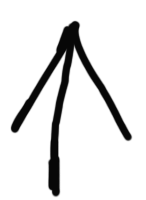from Rose Feather
Cover image: Rose Feather
.gifs, editing: Ksenia Kopalova
Date published: 15 Nov 2025






The 'fly on the wall' bit is misleading. You are never invisible and I don't think it is
something to aim for (we are never sneakily recording people, it needs to be something that is consented to and transparent). We aren't neutral either – our specific bodies and faces take up space in their room, our energy or our tiredness or nervousness or confidence is something that people will be able to feel, and people can feel our gaze when we draw them and write notes on what they are doing. What you see and record will always be impacted by your presence there in some way. So this is something to be aware of, and something to remind your book commissioner when organising this sort of book work.
With this approach, you are invited in as an observer, and the commissioner is interested in a 'fresh' or 'outsider' view of the activity they undertake with participants. You are commissioned to see and listen and then interpret – and they have agreed that what you make will be your interpretation as a book maker and the story will not be a collaboration or further informed by the team or participants. If so, and if this type of approach is appropriate and comfortable for your community group, then it's time to morph into Book Machine and make the final outcome without further consultation. (If not, keep reading.)
If you are going to invite co-creation into the sense-making/ story-making processes then you might morph into Tennis Racket.
If the live illustration/ note taking thing is the right approach but your commissioner needs the book to have a certain theme or tell a particular story, then morph straight into World Builder.
Morphing gone wrong? You can Start Over.


Are your participants are responding to the 'world' you have created without needing you to 'activate' the environment and resources? Great. You could morph into Fly On the Wall With A Sketchbook, and start recording what you see as if it is a live, improvised play happening in front of your eyes. You are going to get drawings, writing and stories directly informed by the community group – but on the right sort of theme. You can also scoop up any drawings or mark makings or writing made by the group, and add that in the book alongside your own art and writing.
Or, have you noticed that some participants have started inventing their own stories, creating new characters, and generally taking the story in a completely new direction? AND is your commissioner happy with the book departing from the set theme, as it is more important to them that the book is participant-led? If yes and yes, it's time to morph into Technician. Enjoy!
Or, have your participants really enjoyed exploring the world you have made for them? Is the book about giving more groups to opportunity to explore a similar world and prompt similar conversations, or even to support group leaders to do a similar thing in their settings? If so, it's time to gather up any drawings or photos or writing the group made during the session, bag up all the materials and objects that made the world, and morph into Book Machine.
Morphing in a muddle? You can Start Over.


Or, you just go in initially and hang out and chat and listen and watch – and all that is the group offering you something to work with. And then you respond in the moment or after a time away, and then they respond to that.
It's story making through negotiation. It's listening or watching, and then retelling it back to someone and them saying 'that's right' or 'that's wrong' or 'that's not really what I meant but it's interesting'. This is co-creation through conversations, verbal or non verbal. Someone makes a painting, and you might respond with a piece of written dialogue. They might make a cartoon in response to that, and you might dress up as one of the characters and do some improv. The painting, the writing, the cartoon and photos or live illustration of the improv set out page by page would make a cracking book.
This approach does need an end, as story making tennis can go on forever. In a way, publishing the book is the final hit of the tennis ball (maybe the shot wins, or maybe it's OUT, or maybe it doesn't go over the net...) If you are ready to strike (or receive) the final ball, morph into Book Machine.
Participants becoming less interested in your responses, and more interested in their own developing practices as artists, writers and story-makers? That's great, but your book isn't ready to cook yet. Morph into Technician.
Morphing gone bad? You can Start Over.


commissioner is happy for the book to be 100% the artwork of the community group (and for your creative voice to be fairly invisible – although of course we can't pretend it isn't still there).
Morphing into technician means your time for coming up with booky ideas is over (phew!), you firmly pass over the reins of the creative direction of the book and pour all your energy into facilitating the ideas, artworks, writings and narratives of the participants. You get the book to be exactly what the group want it to be – that's your new job.
This can look like responding to someone's work by bringing in relevant and exciting reference material to push and/or validate their practice each week, sourcing the right (high quality) art materials for an individual, listening and being a sounding board for ideas without leading. It can look like setting the radio to the right station, making the tea and bringing the right biscuits.
Once your group is happy with the book art, writing and layout design you have made together, time to morph into Book Machine. Are participants losing momentum or starting to need more than just a sounding board? Trying morphing in to Tennis Racket for a session and see if a few new offerings gets the balls rolling again.
Does the commissioner needs you to add an element of reflective practice to the book, and are they keen for you to add your learnings on working with the group and a record of the group as a collective? Morph into Fly on The Wall With A Sketchbook. This will be an interesting approach to take towards the end of a project when a group already knows you well.

hat-wearing book makers, our voice (our values, our past experiences, our taste/preferences, our specific combination of eyes/brains/hands) will come through. The way we encourage someone to develop their work, the way we collage images together during the final page layout stage, the way we interpret people's ideas when we are writing blurbs or accompanying texts. Have a chat about your commissioner about this early on, so they know exactly who they have asked to hold this book making process, and that what you will do isn't the same as what someone else would do - even if they were given exactly the same brief and group of people to work with.

The 'stuff' which make the content of the book might be:
- your own observational drawings or memory drawings, notes from overheard conversations or dialogues you have had;
- drawings, writing, paintings, photography, 3D models, costumes, set design made by the group you have been working with;
- you might have been working with some key materials, objects, textures, colours – and you could scan or photograph these things to go in the book. For example, I held a 5 week book making club for babies and at the end I scanned all the blankets we laid the babies on and that texture was the back cover of the book;
- odds and ends. Off-cuts from abandoned artworks made by a community group, left over holes out of a hole puncher... a photo of the room after you've been working in there all day. Sometimes the material matter of a workshop feels super rich with stories about what you did together, and sometimes it just gives a flavour of how you all felt in the space. I quite like to leave my books a little bit unfinished looking, I like to include the off-cuts and scrappy edges. Usually, it's not a book which tells one story in a straight forward and finished way (so it shouldn't pretend to be), it's a conversation between a whole bunch of people that are real – and this 'off-cutty' visual language can help to communicate that.
There is also stuff from the commissioner:
- Sometimes they need certain text info in the book, and/or an introduction page and/or some blurb on the back. However, it could be that some of this is written by you, or a member of the community you are working with. I once asked some Year 3 students to write an introduction to their book and it's way better that anything I could have some up with.
- Their logos, their funders logos and perhaps a thank you to their funders etc.
- Rarely – an ISBN number. In the past 5 years of making community picture books, I have only ever put an ISBN number on one book. This was a book commissioned by a gallery, and they wanted to sell it in their gallery shop. If you want your book to be sold (beyond just online sales, or in tiny independent shops/ craft fairs etc), you will need it to have an ISBN number and bar code. More info on all that stuff here, but usually this is for you commissioner to sort out.
Staring at the huge pile of stuff and unsure where to start? I often finish the 'making' bit of a project with two or three IKEA bags full of stuff to process. It can be a scary moment!


It's the reader(s)! We need to consider our reader(s)* at this point, as they are waiting expectantly for their book. What experience will this book create for them? A story in which you gently guide them through an engagement with the community group? A lively story which surprises them and makes them laugh? A think-y story which asks them to consider a life which is different to their lived experience and/or motivates them to act or do or make something in response. A joyful story in which they feels seen and celebrated?
To build this story for a specific reader, with all the stuff in your IKEA bags, you could:
- Write an overarching narrative or frame narrative which holds all the creative outcomes of the group and sort of makes sense of it.
- Use your observational drawings alongside the drawings and writings of the group to make a sort of conversation narrative, like you are talking to the group and they are responding and you talk back and they talk back again.
- The shape of the book could follow the shape of the programme of workshops you planned for the group. One of my books follows an imaginary version of one of our workshops: it starts with 'Who's at the door?' and ends with 'Goodbye, see you next time'.
If the commissioner is keen for the book to be as led by the group as possible, it's likely you will need to morph into Tennis Racket and even Technician a couple of times in order to share with the group these processes and include their insights and inputs. I have done this by printing out 'blanks' of book double spreads and led collage workshops with printouts of their artworks which they physically collage together, and then I digitally collage the scans together to mirror their designs. Once, I showed a group of teenagers their book all laid out digitally halfway through the process and it was helpful in terms of refocusing and re-motivating us all to finish the project together.
Ready to lay out your pages and send it off to printers? I download templates from a printing service which I like to use, Mixam, and lay out my pages on Affinity Photo, which is like Photoshop. You can use any sort of software you like. Just make sure you follow the instructions from the printers in terms of sizes of pages (including bleeds etc), and export your final files as high resolution as possible.




So, at the book launch event (party), you can do a giving out books ceremony – or if this feels a bit formal then maybe a personalise-your-own-copy activity. I led an activity in which each child made a book plate for their copy and stuck it in during the book launch – it felt quite neat as the time period of their story was the same as the time period where book plates were popular in the UK. I wonder what sort of book personalisation could feel neat and relevant for your book...
Having a book launch ends the project with the message that the participants' book has value and is something worth celebrating. You can co-plan the book launch with the community group. Perhaps a member of the community who co-produced the book could do a reading or performative storytelling, maybe a another member of the group could lead an activity linked to the way the book's artwork was created, or another person could set up a zine making station to encourage book launch attendees to make their own mini-books.
Wondering where the books can live post-party? Morph into Distributor.
Party done, and project over? Time to End Project, and Morph Back into Original Form.


- In the school library of the children who made the book
- In the galleries of the museum who commissioned the book, free for visitors to pick up and read while they are looking at the objects
- In the gallery shop of the gallery who commissioned the book
- In an online shop to fundraise for the charity who was a partner on the project
- In a pop-up exhibition in a local library, and all the contributors where invited
- In an exhibition for refugee week, in partnership with a charity whose community members co-made the book
- In the bedrooms of the children who made the book, and brought out at bedtime to read before bed
- In the post to Australia for the grandchildren of the book makers
Maybe the last two are the most meaningful. Think about what the book is for, and who is it for, and where it needs to live in order to function most meaningfully. I always keep at least two copies for my own archive!
Feeling like throwing a party now the books have a home? Morph into Party Planner. Did homing the books give the project the final closure it needed? Time to End Project, and Morph Back into Original Form.


Here are some other questions that might get us to an answer:
- Which shape did you feel most comfortable with? Was this a surprise, or something you could have predicted? And, which shape was a challenge for you to morph into?
- Did you have to respond to a project which started shape shifting too? (This often happens to me: a project which initially is all about community engagement shifts into a book which needs to sell to raise funds – or a book which is supposed to be inspired by a famous author shifts to a celebration of children's creative ideas when they playing outside.)
- Did you start to imagine new states you could shape shift into, beyond the ones listed here?
Congratulations on getting through to the end! I hope this process felt useful and offered a collection of possible approaches for a community book making project. If you are starting one, good luck and enjoy! For me, I find shape-shifting a super useful practice for this kind of work – it suits my newness-seeking brain and helps me keep stamina through a project.
- Rose Featherillustrator, community books creator
My idea is doing this co-production process without external requirements or themes or agendas. Although, it's not really working 'without a commissioner' – The Press would be the commissioner I suppose. As I set up this social enterprise I need to work out what an open-ended and expansive 'House Style Guidelines' document would be. As a human being I have my own values and beliefs, and as an organisation The Press will too. But what would The Press do if the book that a book maker wants or needs to write were in contradiction to one or more of these values? Would we publish a book which promoted a single religion? A book which promoted a certain view on a particular gender, or a book with communicated a message that felt uncomfortable to share outside the small
community of people it was intended for? I'd imagine all the answers to these examples are 'no', but it will be interesting to explore how boundaries and guidelines around content can be developed in a way which doesn't close down people's ideas.
I need to figure about the legal bits around intellectual property too. Who owns a co-created book? How can the book maker be credited, celebrated for their work? Is it a licensing agreement, a percentage of sales going to them and/or a charity of their choice? How is consent found and an agreement found between The Press and the book maker? Does that consent last forever? Can a book maker, or The Press retract consent? Lots to think about. But how will it be funded? The bespoke , supported picture book making programmes will be part-funded by grants, but also by offering a picture book making services to organisations who'd like to tell a story about their work – and for that story to live in a lovely book which they can share with potential new clients or funders. These books for businesses will be co-made too, and I'd use many of the approaches above to invite the team to get involved.

rose@rosefeather.co.uk

Bibliography:
Hackett, A. (2021). More-than-human Literacies in Early Childhood. London: Bloomsbury Academic.
Longdon, J. (2025). Natural Connection. London: Penguin Random House.
Sarosy, J. and West, S. R. (2021). How to Tell Stories to Children. Boston: Houghton Mifflin Harcourt.
Sarosy, J. and West, S. R. (2025). How to Tell Stories to Children. [podcast] How to Tell Stories to Children. Available at: https://howtotellstoriestochildren.com [Accessed 14 Nov. 2025].
Taylor, R. E. (2024). Illustration and Heritage. London: Bloomsbury Publishing.
Watfern, C. (2024). How Art Works: Stories from Supported Studios. Abingdon: Taylor & Francis.
Wrench, K. (2024). Skills and Knowledge for Life Story Work with Children and Adolescents. Jessica Kingsley Publishers.
Organisations doing this kind of work, or similar:


































